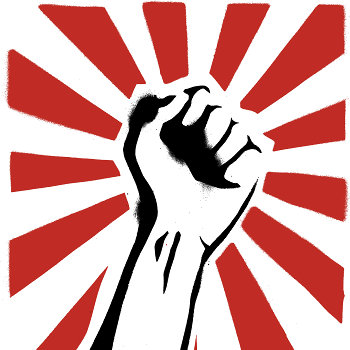

By Kim Voynar Voynar@moviecitynews.com
Digital Distribution Revolution
 Community. Collaboration. Crowdfunding. Distribution.
Community. Collaboration. Crowdfunding. Distribution.
There’s been a growing sense over the past few years that the individual artists who make up the indie film community are connecting to the idea that one way you keep working and making films in a tight economy is to keep your overhead low by forming filmmaking collectives, little pockets of talented film folks working together to get each others projects done. People aren’t sitting around, wringing their hands and waiting for some mythical rich dude on a white horse to come sweeping in to save the day and fund their films, they are just doing whatever they have to do in order to get them made. The advent of DSLR has made it possible for anyone with a 7D and a Macbook loaded with FCP to shoot and edit a film, and this whole spirit of community around filmmaking – you help me get my film made, and then I’ll help you make yours – makes it even easier to shoot a lot of films on a little money.
And all this is great, but the next big question, to which we’re starting to see some answers, is: What do you do with that film once it’s made? How do you get it seen? Do you spend a small fortune on fest entry fees for the crap shoot chance that your film might get into a decently large fest and get you some attention? For the even smaller chance that you’ll luck into the lottery draw of a distrib deal, and that said deal won’t be crappy? What does “distribution” mean now as it applies to indie film, and what will it mean a decade from now?
This morning indie producer Ted Hope tweeted a link to this excellent piece by Brian Newman about “disruptive innovation;” that is, what happens when someone operates in a space that bigger companies devalue (or simply haven’t yet seen the value of).
In his piece, which you should read if you haven’t, Newman talks about four YouTube celebs who are among the most popular subscribed names in that popular space, as an example of how some folks are rejecting the long-held indie filmmaking model for distribution and taking advantage of the current landscape to get their work seen by way more people than they would otherwise. These four people, Newman notes, are getting their work seen by millions, even billions of viewers, simply by taking advantage of YouTube and social networking to extend their reach. It’s a possibility that didn’t even exist a decade ago, this idea of distributing your work through a channel like You Tube.
Newman’s article is relevant and interesting, but it there’s a comment on the piece from Michael R. Barnard that I think makes the point even better and more succinctly: The real digital revolution is about distribution, not just creation. Distribution is the space where disruptive innovation is going to make the biggest shift in the landscape of independent film over the next decade. So the question becomes: How do indie filmmakers take advantage of opportunities to leverage those devalued spaces? So the big guys largely control entry into the mainstream theatrical space. So what? How can you work around that, over it, under it, or through it to bypass traditional entry points and get your work directly to your audience? How can you be a part of redefining what distribution looks like? Because the landscape is changing rapidly.
 Consider: Right now, I know of at least two films that are potential bellwethers for how ready we are to accept this shift, this new wave of indie film distribution. Actor-turned-director Matthew Lillard rejected traditional distribution for his directorial debut, Fat Kid Rules the World, and has instead opted to self-distribute to get his film seen by the world; he’s using a crowdfunding campaign through Kickstarter to made it happen. When he was in Seattle for the film’s SIFF screening, he talked about how none of the majors really “got” how to market a film like Fat Kid; it’s a film in which the two main characters are a boy who ate away his grief over his mother’s death and his friend, an unloved, unwanted, homeless teenage drug addict. There’s no hot sex, no gratuitous nudity, no T&A, no masturbating with warm pastries (I think cleavage makes one appearance, and that’s in a brief fantasy sequence).
Consider: Right now, I know of at least two films that are potential bellwethers for how ready we are to accept this shift, this new wave of indie film distribution. Actor-turned-director Matthew Lillard rejected traditional distribution for his directorial debut, Fat Kid Rules the World, and has instead opted to self-distribute to get his film seen by the world; he’s using a crowdfunding campaign through Kickstarter to made it happen. When he was in Seattle for the film’s SIFF screening, he talked about how none of the majors really “got” how to market a film like Fat Kid; it’s a film in which the two main characters are a boy who ate away his grief over his mother’s death and his friend, an unloved, unwanted, homeless teenage drug addict. There’s no hot sex, no gratuitous nudity, no T&A, no masturbating with warm pastries (I think cleavage makes one appearance, and that’s in a brief fantasy sequence).
Fat Kid is a warm, honest, compelling film, and it’s an impressive directorial debut. Lillard thinks it’s a film with an important message for young people, and he thinks he can get it out to more of them by doing it on his own than through a distributor, and he’s probably right. Honestly, I do think Fox Searchlight, had they been willing to put the effort behind Fat Kid that they have with films like Little Miss Sunshine and (500) Days of Summer and Juno, probably could have really done something with it. It feels like a major ball drop for them not to have picked this up, particularly in the wake of all the publicity over Bully (the film) and bullying (the ongoing problem among our youth today) and, perhaps more to the point, given that Fat Kid really is a solid film. But I’m interested to see how Lillard does with his effort to take his baby out into the world on his own, and I completely admire his strong desire not to compromise his film and its message by giving it any less than the distribution he feels it deserves to have.
 Over on the documentary side of things, the huge news this week is that Oscar-nominated documentarians Rachel Grady and Heidi Ewing (Jesus Camp, Boys of Baraka) have also chosen Kickstarter as the platform for raising the funds they need to self-distribute their latest film, Detropia, a piercing examination of the Motor City’s rapid deterioration from being one of the fastest-growing cities in the nation to a city that’s bleeding population and falling apart. In the economy we find ourselves mired in, Detropia is perhaps one of the most relevant films to come out of the past few years of documentary filmmaking (and as an aside, I kind of want to take Detropia, Charles Ferguson’s No Way Out and Inside Job, and Alex Gibney’s Enron: The Smartest Guys in the Room on tour around the country, showing them to young people so that they can wrap their heads around just how much the grown-ups in charge have completely fucked things up for them).
Over on the documentary side of things, the huge news this week is that Oscar-nominated documentarians Rachel Grady and Heidi Ewing (Jesus Camp, Boys of Baraka) have also chosen Kickstarter as the platform for raising the funds they need to self-distribute their latest film, Detropia, a piercing examination of the Motor City’s rapid deterioration from being one of the fastest-growing cities in the nation to a city that’s bleeding population and falling apart. In the economy we find ourselves mired in, Detropia is perhaps one of the most relevant films to come out of the past few years of documentary filmmaking (and as an aside, I kind of want to take Detropia, Charles Ferguson’s No Way Out and Inside Job, and Alex Gibney’s Enron: The Smartest Guys in the Room on tour around the country, showing them to young people so that they can wrap their heads around just how much the grown-ups in charge have completely fucked things up for them).
About their decision, Ewing noted, “What’s really compelling is how you get the feeling everyone in the community is coming out to help us because they’re going through the same thing. We stopped to really investigate who’s raising money and how are they doing it? This has really brought us back to earth. We’re going to be taking a very big interest in everyone else’s projects. If we don’t support each other’s projects, who’s going to do that?”
Which is exactly the point, right? What’s going on in the indie film world right now is this profound shift in the idea of what it means to be a filmmaking community. How do we support each other in making the work, and how do we support each other in getting the work seen? We do it by forming filmmaking collectives in which people work, essentially, for little or nothing on each other’s projects, to get the films made. By filmmakers supporting each other’s crowdfunding campaigns to raise funds to get films made to begin with, and, perhaps more importantly, distributed once they’re made.
Ewing added, “The fear of entry has gone down, the technology has made it more democratic and accessible, and now it’s about distribution. We have to stop just relying on this fantasy that some holier than though, smarter than you distributor is going to land in your living room and just take it on for you. Even with a distributor you have to do a lot of work, a lot of brainstorming, you have to come to the table with ideas. You still get more press for even a small release in theaters than for television, even now. But there are eyeballs out there, there’s an audience for this work, you just have to work to find them.”
The other thing all this ties into, of course, is something that people like Ted Hope and Christine Vachon have been preaching for years: Independent filmmakers need to get that it’s about business, not just art. Or at least, that there’s an art to the business side of film, and that more filmmakers need to wrap their heads around this concept. Filmmakers should be thinking from the time they come up with an idea for a film about budget, and that means more than just “we’re going to spend X dollars making this film and max out our credit cards.” It means, you need to have a plan before you start making your film for how you are going to make back what you invest in it.
Too many indie filmmakers just go at it flailing blindly, with zero idea of who their audience is and how they’re going to reach them. Is it possible to control spending and losses to the extent that you can guarantee you’ll always make back what you invest in making a film? Probably not, but if you’re smart and looking at both what’s going on now, and what direction things are likely to take in the near future, you can maybe maximize your chances of finding your audience and being able to continue working in this risky and unstable field.
The barrier is, many filmmakers are so invested in thinking of themselves purely as artists that they can’t see that they need to also develop skills in the business side. Does that mean that we need to be mercenary in creating art that “sells?” Of course not. But I believe there is a way to both be true to your artistic vision and to reach the audience that will help support that vision. Ewing sums this idea up thusly, “There’s no reason that we artists have to be silly and stupid about business and there’s nothing crass about it. If a deal stinks, don’t take it, it’s not a requirement, just so you can tell your friends your got official distribution. Filmmakers are notoriously not great at the business side of things and that has to change. People have to be take charge of their own projects. There’s insecurity that comes with making a piece of artwork, and filmmakers have to get past that. The networks need content, audiences want to be moved by stories. There’s a purpose to what we do, there’s a demand, a hunger for a well told story. People are turning to non-fiction films to a greater degree than they ever have before, they’re looking to us to tell those stories.”
I’ve been considering a post that Ted Hope made at his blog a while back, in which he said that a potential film should have at least 5,000 “followers” – that is, people who are legitimately interested in seeing it get made and watching it once it is made – to even get greenlit. 5,000 followers seems a very tall order for any indie filmmaker to achieve before a film’s even been shot, but Ted’s point is that filmmakers should be thinking before they start actually making a film who they’re making it for and how to interest that audience in their film. You don’t need to necessarily aspire to making huge Hollywood tentpoles, but you do need to think about your film as something other than a giant black financial void. At the very least, you want to have a plan that allows you to continue working in filmmaking and not flipping burgers or answering phones in a cubicle, right?
There’s certainly a part of me that longingly wishes I didn’t have to think about this side of things, but most of me has accepted the realitythat this transition to filmmaking is going to require me to call on not just the artistic skills of writing and directing and creating, but also on the business skills I thought I left behind when I walked away from the corporate world 13 years ago to forge new path for myself in this industry. I made my short film, Bunker, as a first step in transitioning into filmmaking as my primary occupation, but my intent is also to keep writing along the way, to share the things I learn – what works, where I trip up and fail. We spent our own money making Bunker, because I viewed that film as boot camp, an investment in learning some things that I needed to learn about being a director on a film set and about translating a story from idea to script to movie. We have a couple of feature scripts we’re developing right now, and the plan is to be filming one of them in 2013. But as I’m working on these scripts, I’m not just thinking about the script itself, I’m thinking about who the audience is and how to reach them. I’m thinking about crowdfunding as a marketing tool. I’m thinking about distribution.
Ewing sums this perspective up nicely:
“In the future we’re going to start thinking about this before we even start production, trying to raise an extra $100K up front and holding that back for distribution. We started out being “Oh shit, we’re gonna have to do this ourselves,” and then it became, “Okay, we’re doing this ourselves!” and we got excited about it and started researching and talking to people and realized how much we didn’t know. Where have we been that we didn’t realize how quickly everything has changed? Now that we’ve launched this campaign we’re like 24 hours into it and we’re getting all this support from the filmmaking community, people making pledges and sending us supportive notes, and it’s been amazing.”















Great article Kim!!